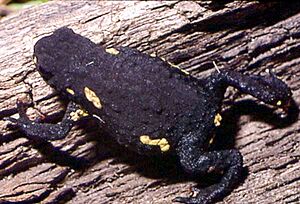Darwin's toad facts for kids
Quick facts for kids Melanophryniscus montevidensis |
|
|---|---|
 |
|
| Conservation status | |
| Scientific classification | |
| Synonyms | |
|
Melanophryniscus stelzneri ssp. montevidensis Gallardo, 1991 |
The Darwin's toad (scientific name: Melanophryniscus montevidensis) is a special type of toad. It belongs to the family called Bufonidae, which includes true toads. You can find this toad in Brazil and Uruguay.
Like other amphibians in its group, the Darwin's toad is known for its bright colors. It also has unique ways to defend itself. Plus, it goes through a quick change from a tadpole to a toad, which is called metamorphosis. Its skin even has special natural chemicals. Scientists are studying these chemicals for possible uses in medicine.
This toad is mostly jet black. It has bright yellow patches on its back and sides. You can also see yellow on its front legs and belly. A cool red spot is found on the underside of its thighs and part of its tummy. Even the palms of its hands and the soles of its feet are red!
Where Darwin's Toad Lives
The Darwin's toad lives in specific natural places. These include warm shrublands and temporary freshwater marshes. It also likes sandy shores. You can find this toad along the coast of the Río de la Plata. It also lives near the Atlantic Ocean. Its range stretches from Santiago Vázquez in Montevideo to Praia da Alvorada in Rio Grande do Sul.
It usually lives in sandy areas near the coast. These areas have special plants that like sand. The toad prefers open spaces with plants. Sometimes, it can also be found in flooded grasslands. It builds small caves in the sand among the plants to hide.
Daily Life and Habits
The Darwin's toad is usually active during the day. This means it is diurnal. Its main food source is ants. But it also enjoys eating small beetles, springtails, and aphids.
Its breeding season is quite short. It typically happens after heavy rains. This is usually from late spring to early autumn. During this time, male toads become territorial. They will protect their space. Their calls change, and males might have short fights. You can sometimes find them in winter after heavy rains too. This happens if the temperature is above 15 °C (59 °F).
When a Darwin's toad is picked up, it often stays still. It might even turn its belly up. This shows off its bright red and yellow colors. This special defense move is called the Unken reflex. It warns predators that the toad might be poisonous.
Protecting the Darwin's Toad
The Darwin's toad is a species that needs our help. In Uruguay, it is considered Critically Endangered. This means it is at a very high risk of disappearing. Globally, it is listed as Vulnerable.
The biggest threat to this toad is habitat loss. The areas where it lives are being built up by people. This is called urbanization. Scientists also worry about climate change. Some studies predict that the right weather conditions for this toad might disappear. This could lead to its extinction by the middle of the century. This is because its breeding depends on specific rainfall and warm temperatures.
See also
 In Spanish: Rana de Darwin para niños
In Spanish: Rana de Darwin para niños


